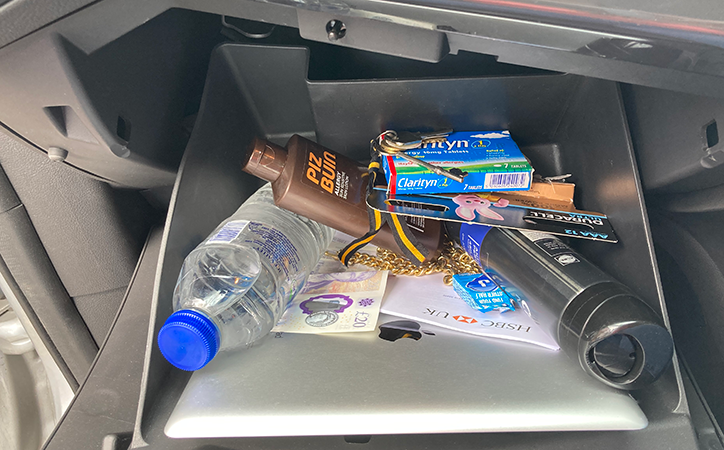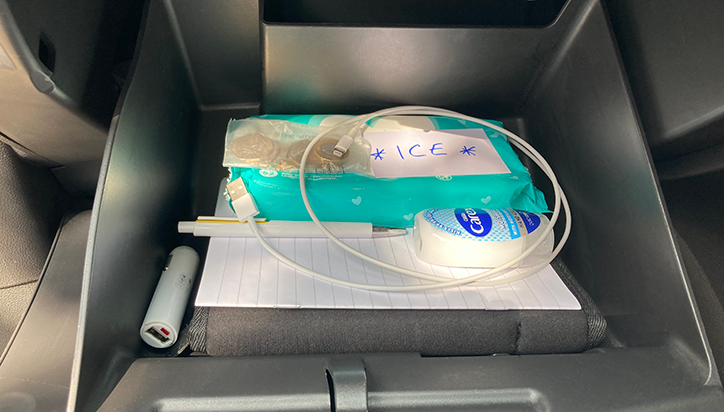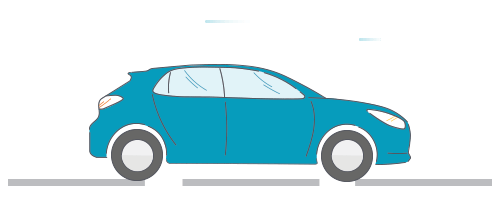Modern vehicle developments are astounding; recently we’ve even seen the first journey of a flying car! Yet every vehicle on the road has a feature called a ‘glovebox’, so-called because its primary function was to store driving gloves that haven’t been strictly necessary for over 70 years!
To be honest, we hope the nostalgia stays and this historical little compartment remains a feature in vehicles for the next 70 years. But what do you actually keep in yours? We’re guessing not a pair of driving gloves and probably a few surprises if you haven’t cleared it out for a while!
A quick quiz around the team (and a nip out to their cars) revealed that our desks seem to mimic our gloveboxes… Some contain a minimal selection of important documents and emergency essentials, while others featured random items including long-expired holiday parking permits, loose toffees, broken CD cases, ketchup sachets. But what should be in there?

Before you feel smug about the organised contents of your glovebox – ready to help you out in any emergency – take a look at some of the items that are actually advised against.
Documents
Valuables
Electronics
Money
Keys
Batteries
Aerosols
Medicine and sunscreen
Plastic water bottles
Chewing gum

Your glovebox may seem like the sensible place to keep all your car’s documents, but it’s the first place thieves will look if they break into your car. If the vehicle itself is stolen, you’ve handed them all the documentation they’d need to sell the car easily!
Any document that features personal information or your home address (including that invoice from your last car service) should be kept well away from your vehicle. Some unfortunate people have even had their house burgled before they’ve realised their car was missing! Others have had information used to make applications for credit cards and all sorts of ID theft.

While it’s a good idea to stow valuables out of sight if you don’t want to take them with you, sadly your glovebox isn’t a safe! Try to plan in advance and either leave your valuables at home or take them with you when you leave the car.
It’s also worth bearing in mind that a lot of car insurance policies don’t cover personal items stolen from your car – if you regularly have to leave your phone or other expensive items in your vehicle, make sure you check your policy to see if they’re covered.

These days, the latest electronics would definitely be counted as valuables, but they get their own category here purely for storage issues. Extreme temperatures do not agree with devices and leaving electronics in particularly cold or hot conditions can result in permanent battery damage.
A phone exposed to heat exceeding 35˚C can be left with data loss, corruption and battery damage. Seeing as a parked car left in 35˚C can reach 46˚C in just an hour, it’s pretty easy to see why your phone shouldn’t be stored in what would act like an oven within the car! It’s not just the heat that can cause problems for your electronics, and again the glovebox won’t provide any protection, extremely cold temperatures can cause shorter battery life, display problems and unexpected shut-downs.

It might be a long time since we kept a chequebook in the glovebox! But people are often guilty of stowing their wallet or purse in the glove compartment if they don’t need them for the trip they’re making. As before, your glovebox isn’t a safe and thieves will make short work of pinching your cash or accessing your accounts if you’ve left cards in the car.

It might seem obvious, but many of us make the mistake of keeping our bulky main keys, spare sets and/or garage door openers in our parked cars. If you’ve left documents in your glove box too, you’ve just made burgling your house as easy as it gets. It might seem convenient to keep keys in the car, but for the sake of carrying a bag or finally putting up that hook for the spare set at home, we think it’s worth the effort to stay safe.

If you are organised enough to keep a supply of batteries on hand we’d usually be congratulating you, but heat speeds up the chemical deterioration of batteries and can even cause them to leak. Don’t store any loose batteries or any battery powered items in your car when it may over-heat or they could cause damage to the item itself or whatever they’re stored in.

There’s a reason that things stored in aerosol cans—like hairspray, spray paint, and deodorant—all have storage temperature recommendations printed on the bottle. If left out in extreme temperatures, these cans can expand and explode, and their contents are highly flammable.

Medicines and sunscreens are generally supposed to be kept at room temperature so this is another tip affected by the weather. These products become less stable and less effective. Liquids can even reach a temperature where they explode… which isn’t a great result for the rest of your glovebox contents.

While it seems like a sensible idea to keep water in the car, it really needs to be something you refresh every trip. A plastic bottle left in the car for a long time could have leaked harmful substances like BPA into the water and/or may have started to harbour microorganisms.

While it seems like a sensible idea to keep water in the car, it really needs to be something you refresh every trip. A plastic bottle left in the car for a long time could have leaked harmful substances like BPA into the water and/or may have started to harbour microorganisms.

‘Should’ is obviously different for every person – some of us may feel that a long journey without a stash of Haribos in the glovebox is impossible – but we’re using the word ‘should’ for two different categories here, ‘essential’ and ‘helpful’. Plus, remember that these are items for your glovebox, not a full list of what should be kept in your entire car!
Medical information
Essential contacts
Pen & paper
Car manual

While we hope they’ll never be needed, being prepared with this type of information could save your life… If you or your family/regular passengers, have a medical condition, allergies, or are on any medication that people should know in case of an emergency, keep the information visible at the top of your glovebox. It could help emergency personnel in the case of an accident. A proper ICE card (In Case of Emergency) would also include emergency contacts. No addresses or other personal information needs to be on here – just phone numbers.

You may have an emergency that isn’t an accident and you can’t rely on your phone in case it breaks, runs out of battery or gets damaged or forgotten. Keep a piece of paper (or if you want to be seriously organised, a laminated sheet!) with all the emergency contact numbers including family, your insurance company, preferred emergency garage etc, you may need inside your glove compartment.

It’s a simple one, but again, if electronics let you down and you are involved in an accident and need to exchange information, a good old pen and paper is a must.

You don’t need to store the entire manual in the glovebox – your stereo acting up won’t stop you from being able to drive safely! – But it’s worth keeping the main manual to hand. There may be a situation where you need to know how to fix something, turn something on or off, or what recommended settings are such as tyre pressure. Keeping your car manual at hand will mean you can access that information quickly and easily… And will help you figure out what those weird symbols on the dash mean!
Here’s some extra items that can be handy to keep in your glovebox if you have enough space.

Before you think we’ve already forgotten our own advice, we’re not suggesting a battery-powered flashlight. There are effective wind-up torches available that will provide light whenever you need them, whether that’s in a night-time emergency or identifying whatever fast food item has fallen down the side of your seat!

While we’ve suggested the sensible back-ups in the event of an emergency when you phone isn’t working, a mobile is still undeniably the most useful item to have working in most situations. So, it’s worth keeping a cable charger handy that you can plug into your car’s USB port, or, if you own an older car, the cigarette lighter adapter!

Since the reports last year that you shouldn’t store hand sanitiser in your car due to it posing a fire risk, The National Fire Chiefs Council has announced that while they should be kept closed and out of direct sunlight, hand sanitisers only pose a risk when exposed to a spark. So actually your glovebox is the perfect place for a small bottle of hand sanitiser and it’s something we should all have ‘to hand’ 🙂

This is a small and useful tool to have on hand in the event that your tyres have low air pressure.

This is one for the pet owners really. Whether it’s your car seats or your own outfit, a cheap lint roller can give you or your upholstery a spruce up in seconds.

Keeping a bag for life folded in your glovebox means you’ll never be caught without if you stop off at the shops, and it will provide an emergency rubbish bag if needed.

Obviously we’d advocate the recyclable options, but it’s always a good idea to have tissues and wet wipes in your car. Just remember that wet wipes can dry out if they are kept in there a long time.

Most payments are made electronically these days and, as we’ve already advised, you should never keep a large amount of cash in the car, but a small bag of change for things such as event parking is a great back-up for spontaneous stop-offs or old car parks!
We hope our guide to what you should and shouldn’t keep in your glovebox has been helpful. We’d love to see your before and after photos if you decide to take our tips onboard and have a glovebox tidy!
Don’t forget if you sell your car with us then you need to empty your glovebox before we take it away. Sadly we can’t return items that have been left in your car… Although we did once make an exception for a Tracey Chapman CD featuring ‘Fast Car’. Had to be done.




